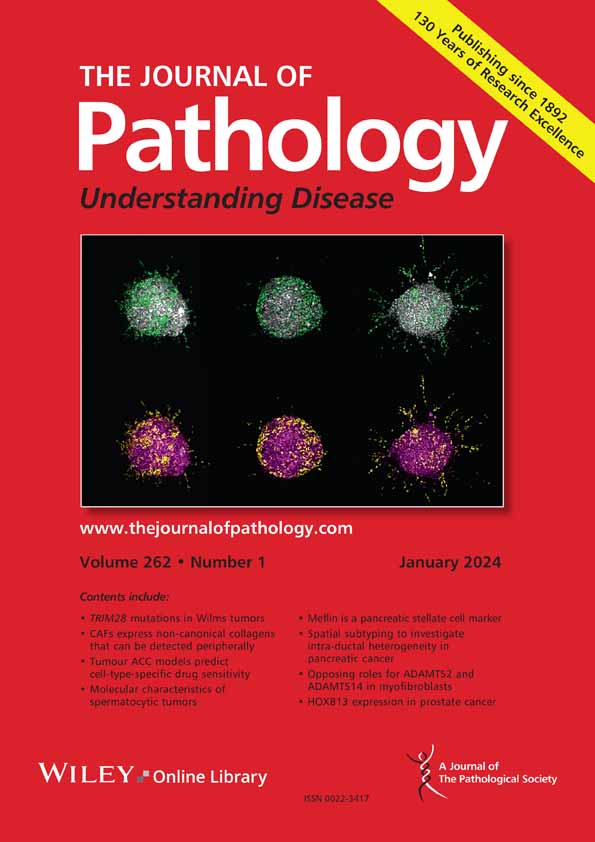Carla Saoud, Josephine K Dermawan, Narasimhan P Agaram, Marc Rosenblum, Tejus A Bale, Cristina R Antonescu
求助PDF
{"title":"Soft tissue sarcoma with MN1 gene fusions: a report of three cases with aggressive clinical behavior","authors":"Carla Saoud, Josephine K Dermawan, Narasimhan P Agaram, Marc Rosenblum, Tejus A Bale, Cristina R Antonescu","doi":"10.1002/path.6441","DOIUrl":null,"url":null,"abstract":"<p>Canonical <i>MN1</i> fusions with either <i>BEND2</i> or <i>CXXC5</i> gene partners represent the molecular hallmark of astroblastoma, a stand-alone group among central nervous system (CNS) high-grade neuroepithelial tumors based on their distinct methylation profile. Outside the CNS, <i>MN1</i> fusions have been rarely reported, mostly with nonrecurrent gene partners. Herein, we present three cases of soft tissue sarcomas harboring <i>MN1</i> gene rearrangements, two of which had <i>MN1</i> (exon 1)::<i>CXXC5</i> (exon 2) gene fusion and the last had <i>MN1</i> (exon 1)::<i>ZFP64</i> (exon 2) gene fusion. The tumors occurred in young to middle-aged adults (two females and one male) and involved the preauricular, abdominal, and sacral soft tissue. Patients with <i>MN1</i>::<i>CXXC5</i> fusion had widespread metastatic disease at presentation. Histologically, tumors with the <i>MN1</i>::<i>CXXC5</i> fusion showed nests of monomorphic round and focally spindled cells, compatible with round cell sarcoma, while <i>MN1</i>::<i>ZNFP64</i> fused tumors exhibited monomorphic spindle cells arranged in storiform and short fascicular patterns. Mitotic activity was brisk in all cases; however, tumor necrosis was minimal to absent. <i>MN1</i>::<i>CXXC5</i> fused tumors exhibited CD99 and S100 expression, an immunophenotype that is not specific for a particular line of differentiation and is distinct from astroblastoma. <i>MN1</i>::<i>ZNFP64</i> were positive for p63 and androgen receptor (AR) expression. Low tumor mutation burden and low levels of genome alteration were seen in all cases. DNA methylation profiling showed that the three cases could not be classified into any of the current methylation classes using the DKFZ classifier for sarcomas (version 12.2) or CNS tumors (version 12.8). T-distributed Stochastic Neighbor Embedding analysis revealed that the three sarcomas with <i>MN1</i> gene rearrangement clustered together, forming a distinct group, in close proximity to epithelioid sarcoma, separate from CNS high-grade neuroepithelial tumor with <i>MN1</i> alterations. In our series, all three cases exhibited aggressive clinical behavior; notably, the two patients with <i>MN1</i>::<i>CXXC5</i> gene fusion sarcomas succumbed to the disease within 20 to 23 months. © 2025 The Pathological Society of Great Britain and Ireland.</p>","PeriodicalId":232,"journal":{"name":"The Journal of Pathology","volume":"266 4-5","pages":"435-446"},"PeriodicalIF":5.2000,"publicationDate":"2025-06-12","publicationTypes":"Journal Article","fieldsOfStudy":null,"isOpenAccess":false,"openAccessPdf":"","citationCount":"0","resultStr":null,"platform":"Semanticscholar","paperid":null,"PeriodicalName":"The Journal of Pathology","FirstCategoryId":"3","ListUrlMain":"https://pathsocjournals.onlinelibrary.wiley.com/doi/10.1002/path.6441","RegionNum":2,"RegionCategory":"医学","ArticlePicture":[],"TitleCN":null,"AbstractTextCN":null,"PMCID":null,"EPubDate":"","PubModel":"","JCR":"Q1","JCRName":"ONCOLOGY","Score":null,"Total":0}
引用次数: 0
引用
批量引用
Abstract
Canonical MN1 fusions with either BEND2 or CXXC5 gene partners represent the molecular hallmark of astroblastoma, a stand-alone group among central nervous system (CNS) high-grade neuroepithelial tumors based on their distinct methylation profile. Outside the CNS, MN1 fusions have been rarely reported, mostly with nonrecurrent gene partners. Herein, we present three cases of soft tissue sarcomas harboring MN1 gene rearrangements, two of which had MN1 (exon 1)::CXXC5 (exon 2) gene fusion and the last had MN1 (exon 1)::ZFP64 (exon 2) gene fusion. The tumors occurred in young to middle-aged adults (two females and one male) and involved the preauricular, abdominal, and sacral soft tissue. Patients with MN1 ::CXXC5 fusion had widespread metastatic disease at presentation. Histologically, tumors with the MN1 ::CXXC5 fusion showed nests of monomorphic round and focally spindled cells, compatible with round cell sarcoma, while MN1 ::ZNFP64 fused tumors exhibited monomorphic spindle cells arranged in storiform and short fascicular patterns. Mitotic activity was brisk in all cases; however, tumor necrosis was minimal to absent. MN1 ::CXXC5 fused tumors exhibited CD99 and S100 expression, an immunophenotype that is not specific for a particular line of differentiation and is distinct from astroblastoma. MN1 ::ZNFP64 were positive for p63 and androgen receptor (AR) expression. Low tumor mutation burden and low levels of genome alteration were seen in all cases. DNA methylation profiling showed that the three cases could not be classified into any of the current methylation classes using the DKFZ classifier for sarcomas (version 12.2) or CNS tumors (version 12.8). T-distributed Stochastic Neighbor Embedding analysis revealed that the three sarcomas with MN1 gene rearrangement clustered together, forming a distinct group, in close proximity to epithelioid sarcoma, separate from CNS high-grade neuroepithelial tumor with MN1 alterations. In our series, all three cases exhibited aggressive clinical behavior; notably, the two patients with MN1 ::CXXC5 gene fusion sarcomas succumbed to the disease within 20 to 23 months. © 2025 The Pathological Society of Great Britain and Ireland.
MN1基因融合软组织肉瘤:3例侵袭性临床表现报告。
典型MN1与BEND2或CXXC5基因伴侣的融合代表了星形母细胞瘤的分子标志,星形母细胞瘤是中枢神经系统(CNS)高级别神经上皮肿瘤中基于其独特甲基化谱的独立群体。在中枢神经系统外,MN1融合很少报道,主要是与非复发性基因伴侣。本文中,我们报告了3例MN1基因重排的软组织肉瘤,其中2例MN1(外显子1)::CXXC5(外显子2)基因融合,最后1例MN1(外显子1)::ZFP64(外显子2)基因融合。肿瘤发生于青年至中年人(两名女性和一名男性),累及耳前、腹部和骶骨软组织。MN1::CXXC5融合患者在就诊时存在广泛的转移性疾病。组织学上,MN1::CXXC5融合后的肿瘤表现为单形圆形和局灶梭形细胞巢,与圆细胞肉瘤一致,而MN1::ZNFP64融合后的肿瘤表现为单形梭形细胞呈故事状和短束状排列。所有病例有丝分裂活跃;然而,肿瘤坏死极少至不存在。MN1::CXXC5融合肿瘤表现出CD99和S100的表达,这是一种免疫表型,对特定的分化系没有特异性,与星形母细胞瘤不同。MN1::ZNFP64表达p63和雄激素受体(AR)阳性。所有病例的肿瘤突变负荷低,基因组改变水平低。DNA甲基化分析显示,使用肉瘤(版本12.2)或中枢神经系统肿瘤(版本12.8)的DKFZ分类器,这三个病例不能被分类到任何当前的甲基化类别中。t分布随机邻居嵌入分析显示,3例MN1基因重排肉瘤聚集在一起,形成一个独特的组,与上皮样肉瘤接近,与MN1改变的中枢神经系统高级别神经上皮肿瘤分离。在我们的研究中,所有三个病例都表现出侵略性的临床行为;值得注意的是,两例MN1::CXXC5基因融合肉瘤患者在20至23个月内死亡。©2025英国和爱尔兰病理学会。
本文章由计算机程序翻译,如有差异,请以英文原文为准。



 求助内容:
求助内容: 应助结果提醒方式:
应助结果提醒方式:


